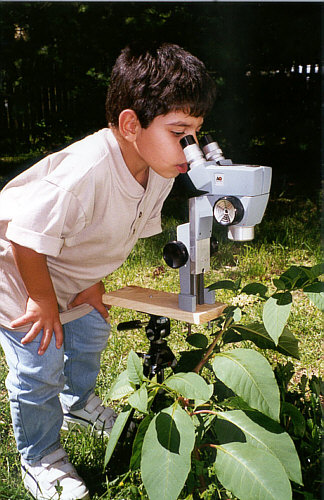"Don't leave home without a Hastings" has become my motto, and I make every effort to remember to take my 7x and 14x Hastings triplet magnifiers with me whenever I am going to the woods, the beach and even my backyard. These magnifiers appear to be the best hand lenses available, but they can't match the image clarity and comfort that can be obtained with a stereo microscope. So, I have long considered modifying a stereo microscope for outdoor use. But until recently the fear of damaging the only one I owned prevented me from any attempts.
A few months ago, I bought a new stereo zoom microscope to use in my basement "laboratory". The previous one I had, an American Optical Cycloptic from the 1970s, was demoted, covered with a plastic bag and placed under a table. However, it was still functional and at magnifications up to 20x its image quality was pretty good. So, a short time later I decided to promote it to the rank of "outdoor microscope".
But first, I had to build an outdoor stage for it. Fortunately, the heavy base is easily removed. Once this is done, the two screws that secured the base may now be used to attach the rack and pinion focusing mechanism, which in turn holds the scope proper, to any sturdy but lighter support. Lacking access to a machine shop, I chose to work with wood and settled on the simplest solution I could think of. A 2x9x25 cm piece of wood was to be the new base, through which I had to drill only three holes: two to attach the scope and one to attach a camera tripod. The result is in the picture. If necessary, to prevent the tripod from tipping over, I hang a plastic bag of rocks from the opposite end of the wooden base. Since rocks are almost always available outdoors, this practical solution makes it unnecessary to lug a permanently attached heavy counter weight.

My son is trying out
the outdoor
stereo microscope.
If I intend to look at objects on or near the ground and if the tripod doesn't let me get close enough, I attach the microscope, again with 2 screws, to a 16x100 cm piece of wood. I place this set-up on the ground and lay on it. My body is now the counter weight and the scope is right in front of me. Of course, if you have a pole-mounted scope, you can simply swing it around the pole and place it on the ground. But you may still need a counter weight on the base to prevent the scope from tipping over.
Stereo microscopes with different designs can be easily attached, if necessary with minor modifications, to camera tripods or other sorts of stages for outdoor use. However, I wouldn't try this with a new and expensive scope; one careless bump and the scope could be damaged beyond repair. But with reasonable care and some ingenuity, worlds difficult to see with hand lenses are waiting to be explored outdoors. My motto may soon become "Don't leave home without a stereo microscope".
Comments to the author Aydin Örstan welcomed.